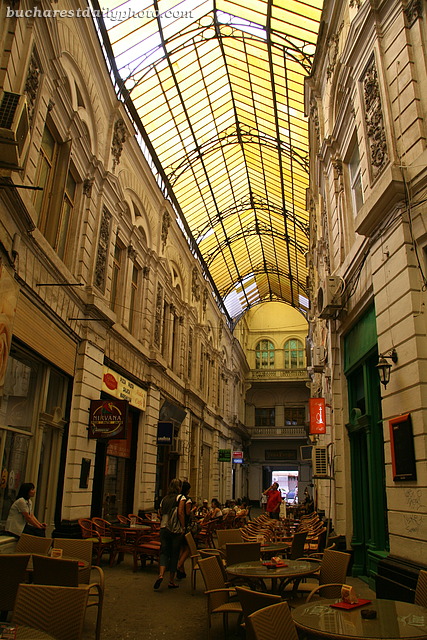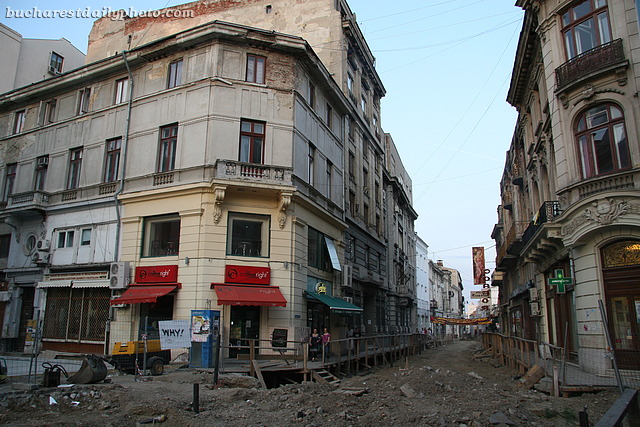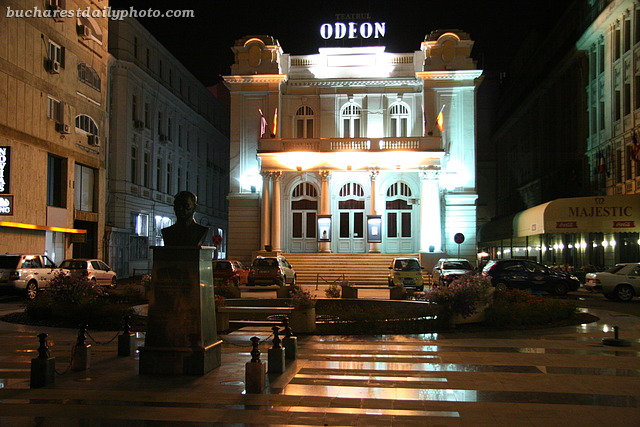Vilacrosse and Macca are the two wings of a U-shaped pedestrian passage roofed with glass and wrought iron and lined with shops, cafes and restaurants. It’s one of the popular places for an outing with friends in Bucharest, the advantage being that you’re sheltered in case of rain but you’re still “outside”, in natural light. In this place you’ll find something for everyone: there’s are a couple of Egyptian cafes were you can puff at narghiles, a rock themed Blues Cafe with pretty good music, a Romanian restaurant, a French Bistro, even a Chinese restaurant. I’ve spend hours here sipping wine or drinking coffe and chatting with friends. It’s not easy to find an empty table on a summer evening. The passage was built in 1890-1891 after a design by architect Felix Xenopol. This elegant arched structure was probably intended to look French since this was back at the end of the 19th century when they aspired to transform Bucharest into “little Paris”, but the feel today is more Oriental than Western. During the communist period the passage was renamed Jewellery Passage (Pasajul Bijuteria) because the city’s largest jewelery store was located close by. It’s original name was restored in 1990.
Bucharest’s Old Town, also called Lipscani area or Historical Centre, is what was left after the former communist dictator Ceausescu finished the work done by the allied bombings of 1944. And what’s left – around 300 historical houses, a few churches and the remains of the old palace and court of Vlad Ţepeş (1459-1462) – is unfortunatelly for the most part managed by Bucharest’s City Hall which has spent years delaying the most needed restorations. Old Town was Bucharest’s merchant area starting with the middle of the 17th century until the middle of the 20th century when the owners were arrested by the communists and the houses were taken over by the Gypsies. The Gypsies didn’t take good care of the buildings so the houses slowly degraded. Nowadays some of the owners or their heirs came back to reclaim the properties but some are still disputed and degrading still. Some of the buildings have been restored and are now functioning as restaurants, cafes or shops as on Smârdan Street. Finally, in 2006 the City Hall chose a Spanish company to start rebuilding the infrastructure in the Historical Center but early this year the project was stopped due to a quarrel between the City Hall and the contractor. A few streets are already restored but most of them are pretty difficult to walk as they were dug up for the planned street repairs. I’ve heard many people say that this area has great potential and it could transform into something unique in Europe. It seems like the City Hall achieved this already. It is indeed unique to walk along rudimentary wooden planks in the center of an European capital.
Continuing the nightly walk along Victory Road, at number 40 we find a little square with a fountain and in the background the beautiful building of the Odeon Theater. I researched the history of the building before writing this post and found out that the building and the piece of land it’s built on changed many hands and was used for many things during the years. I guess that’s probably normal for a piece of land with such a good location. In the end I decided to spare you all the little details regarding ownership and functionality. It’s Friday and it’s time for having fun rather than a history lesson. I’ll only say that the theater was built in 1911 and that its auditorium is probably the most elegant among all of Bucharest’s theaters. The statue in the foreground is that of Kemal Ataturk, the founder and first president of the Republic of Turkey.









